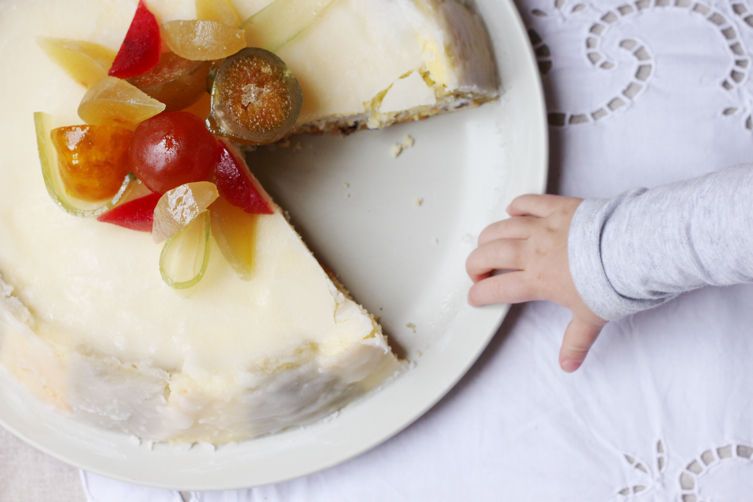
introduction to sicilian desserts


SICILIAN DESSERTS IN PAGAN TIMES
Prior to and during the Greek and Roman occupations of Sicily, each feast was celebrated with offerings to the gods or goddess associated with the season and extraordinary dishes of special desserts were made for that particular occasion.
The sun god was especially venerated in Sicily, as it was in the known world. The sun and the moon were part of the religious beliefs of all the people, thousands of years ago, even before the Egyptian civilization was born.
In mythology, Sicily, the island of Trinacria, was sacred to the sun-god and there was a special devotion to Helios (the Sun) who had his daughters, the goddesses Lampetia and Phanthusa as the guardians of Trinacria. There he kept seven herds of cattle and seven flocks of sheep to be grazed, attended and guarded by the goddesses.
In fact when Odysseus landed in Sicily and his men killed and ate some sacred cows, they were killed as a punishment for their sacrilegious act.
Since ancient times it was noted that the sun had enormous power on the earth and natural events. In order to explain those natural phenomena, mankind created myths, gods and goddess.
Usually, the Sun deity was represented by a male figure and was associated with births and the revival and growth of the earth. The moon was portrayed as a female deity and identified with the night, the underworld and to bolster fertility.
THE TRANSIENT ERA
When Jesus Christ was born and the new Judeo-Christian religion was introduced, the Christian religion was badly accepted and outlawed. The neophytes Christians in order to celebrate the holy days without being too evident and to avoid incarceration or crucifixion, made the Christian celebrations coincide with the pagan festivities. When Christianity was accepted, many of the pagan feasts endured but were transformed into Christian holidays. They were a mixture of ancient pagan traditions and magic, combined with the rituals of the new Judeo-Christian faith.
The most evident Sun’s astronomic observations were made in pre-historic time and in more recent times called Spring Equinox, Summer Solstice, Autumn Equinox and Winter Solstice.
Equinox derives from Latin equus, equal and nox, night and meaning that day and night have the same length.
Solstice derives from Latin sol, the sun and sistere, to be immobile and it was believed that the Sun was standing still because of the minimal movement going from North to South.
LUPERCALIA, THE CANNOLI AND CARNIVAL’S DESSERTS
Lupercalia was a colorful festival celebrated on February 15th to honor Lupercus, the god of fertility. It concurs with our Saint Valentine Day, the day in which lovers exchange gifts and sweets. The plain tortes, offered in ancient times have been replaced with fancy chocolate candies and chocolate cakes.
Cannoli go back to the pre-Hellenic era, almonds were consumed since pre-historic times and the honey produced in Sicily was traded all over the known world.
The cannoli were originally prepared at the beginning of spring and for weddings; they consist of a tube of fried dough stuffed with ricotta cream in the shape of sculptured stones venerated as the symbol of the male fertility. For Carnival, a festivity before Lent and also for the pagan feast of the regeneration, cannoli were consumed abundantly.
Sanguinaccio (a pig’s blood and honey pudding), Pietrafennula (almond, honey and citron cookies) and Torrone (almond and honey nougat) are made at this time of the year in every town.
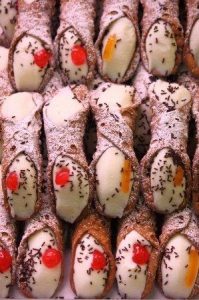

DEMETER AND SAINT JOSEPH (MARCH 19TH)
Spring Equinox occurs around March 20th. During this period it is time to place seed in the ground and to celebrate the goddess of fertility of the land, Demeter for the Greeks or Ceres for the Romans.
The Sun deity was worshiped to gain his blessings so that new life would come in their families.
On the previous night of the Spring Equinox, it was tradition to collect pieces of wood, broken furniture or anything else that was useless and form a pile, to burn along with all the misery of the past year and to welcome the new spring. To the goddesses of fertility were offered fritters in the form of breasts of virgin and cakes made with honey and must. The early products of the land were cooked and offered to the gods together with eggs, the symbol of birth, a common tradition among the Persians, Armenians, Jews, Romans, Greeks and Germans.
This holiday coincides with Saint Joseph’s day and even at the present time all over Sicily, in particular in Palermo, the night of March 18th big piles made of wood, old furniture and junk are burned in honor of Saint Joseph. The breasts of a virgin are made and called Sfingi di San Giuseppe, they are fritters stuffed with ricotta cream.
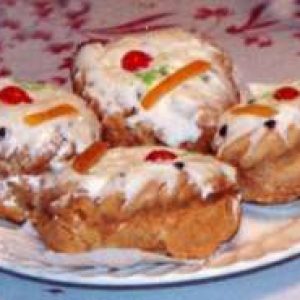
This holiday is celebrated in every house with a table full of bread along with pasta with fennel sauce. The wild fennels are fresh from the countryside and the pasta is served covered with toasted breadcrumbs on top, to symbolize the sawdust in Saint Joseph carpentry. Also the maccu (a fave and fennels dish) is offered as it was in the pre-Christian era.
THE ANNUNCIATION TO THE VIRGIN MARY (MARCH 25TH)
Around this time the Annunciation recurs, when it was revealed to the Virgin Mary that she was to give birth to Jesus Christ. This is the beginning of a series of Christian holy days that coincide with ancient pagan celebrations and the sun festivals. In fact, nine months later Christmas is celebrated, at a time when the pagans were celebrating Saturnalia in Rome or the season of Yule in Northern Europe.
THE CASSATA AND EASTER DESSERTS
A famous Sicilian cake is the Cassata. This is a colorful torte made with ricotta and covered with honey and fruits: originally it was offered to the earth goddess to secure fertility and the blessing to the spring sowing.
Many scholars assert that cassata derives from the Arabic word “qas’a”, meaning a small box and not from the Latin word “caseus”, which means cheese. Since the ricotta cheese is the main ingredient in the cassata, this word can derive from “caseus” even if we overlook the fact that Sicilian cooks were employed by the elites of the Roman high society and Latin was the most used language a long time before the Arabs came to Sicily. The Arabs contributed a great deal to the Sicilian cooking but their influence has been greatly overstated. They introduced many new spices from the Orient, gave Saracen names to some dishes, made contributions to agriculture by creating small farms individually owned and by building a modern irrigation system.
The truth is that cassata is as Sicilian as the apple pie is American.
Today the cassata is made with a sponge cake stuffed with ricotta cream, covered with candied fruits, fragrant with cinnamon, citrus fruits and it is the classic Sicilian Easter dessert.
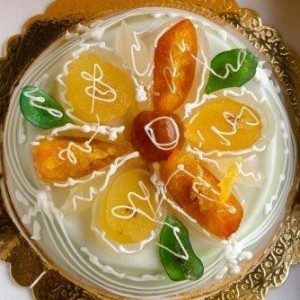
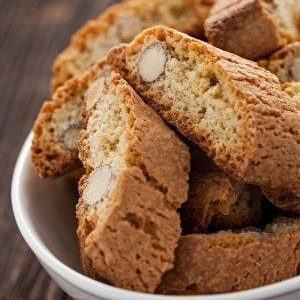
In this period and in more recent times, the famous Quaresimali (the Lenten almond-crunchy cookies) are made, they can be consumed during periods of fasting because they contain no fat.
During the Summer Solstice in Egypt the flooding of the Nile, fertilize the land alongside the river, and it was celebrated with festivals in honor of Isis; in Greece, Aphrodite and Adonis were honored with preparation of special food and women entertained their lovers dancing and singing.
In Rome the festival of Versalia was celebrated in honor of Vesta, the goddess of the family and of the hearth and on the hearth sumptuous banquets were prepared and the women cuddled their men to amuse and to produce offspring.
In Sicily the Summer Solstice is characterized by warm sun, with nature in bloom, with the wheat ready to be harvested and other crops ready to reap. It is time to make preserves for the winter with the fruits gathered and it is a special time when weddings are celebrated. Cannoli and cassate are the desserts consumed for those occasions.
MOTHER’S DAY AND FATHER’S DAY (MAY AND JUNE)
This period also coincides with the pagan holiday of Mother Earth which later was transformed into Mother’s Day the second Sunday of May and into Father’s Day, celebrated on the third Sunday of June and it coincides with the feast of the sun god. For those holidays rudimental cakes were offered: dough baked with fresh fruit on top and covered with honey and later transformed into the crostata, a shortbread tart covered with preserved fruits.
HALLOWEEN, ALL SAINTS DAY, ALL SOULS DAY AND THANKSGIVING (NOVEMBER)
The Autumn Equinox falls in September. The wine making season: grapes are crushed and fermented to make wine. The mostarda, a super concentrated marmalade made with grape juice, almond flour and fragrant with the zest of citrus fruits, is prepared. This delicacy is kept to be offered to friends and neighbors on special occasions. This is an exclusive Sicilian specialty that cannot be found anywhere else.
In October, Ceres was celebrated by the Romans and in Sicily grain and ricotta cakes were offered to the goddess of the harvest.
In the month of November, as it has been for thousands of years, the weather changes. The earth has to be fertilized and sowed, the livestock has to be moved into sheds to protect them from the winter cold and in Sicily the occasion was celebrated in historical times with banquets, rituals and myths. To thank the gods for the harvest and to wish for abundant crops for the following year, large trays of fresh fruits, cookies and other offerings were prepared and consumed with formal ceremonies. In later times when the Judeo-Christian religion became official, this holiday was replaced by All Saints’ Day and the next day was dedicated to honor the Dead.
In fact, the dead were venerated on Feralia. Feralia was celebrated in Roman times on February 22nd, to honor the family’s dead and to pacify the evil spirits and gain their favors. In Sicily this occurrence was celebrated with offerings of baked goods and almond and honey cookies. However, the Christians changed this holiday to All Saints’ Day and All Souls Day, the Day of the Dead until Pope Gregory IV moved this holiday to November.
In the Giorno dei Morti, All Souls Day, in preparation for the evening traditional celebrations, large trays are filled with dry and fresh fruits, with Tatu’ (a walnut shaped almond flavored cookie), Pipatelli (honey cookies with a strong cloves flavor), Muscardini or Ossa di Morto (bones of the dead cookies, made with a brown honey base and a white top in various shapes) and colorful fruits made with marzipan, called Frutta di Martorana. An interesting fact is that Arabs introduced sugar to Sicily, making it possible to transform the almond paste, originally manufactured with honey, into marzipan, the Pasta Reale.

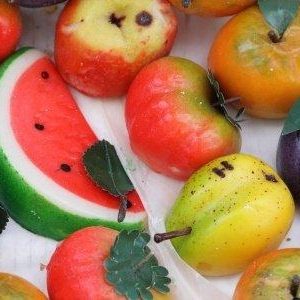
The eve of All Saints’ Day, is celebrated in the United States and in Canada and called Halloween.
The harvest time was celebrated in England as Thanksgiving and became established in the United States and in Canada and observed on the third Thursday of November.
THE IMMACULATE CONCEPTION (DECEMBER 8TH)
Pietrafendola or Petrafennula is made with honey, skins of citrus, fruits, almonds, confetti and cinnamon. It is a very hard candy that is like a “pietra”, a rock and “fendola” meaning to be cut.
SAINT LUCY’S DAY (DECEMBER 13TH)
On December 13th, Saint Lucy Day it is tradition not to eat any bread and delicacies like the Cuccia, cooked grain with cream, cannoli cream and honey and the Arancine, rice balls are prepared for the family and guests.

CHRISTMAS (DECEMBER 25TH)
The Winter Solstice that occurs on December 21st or 22nd is dedicated to the sun-god.
In all pagan faiths the sun-god was honored around December 25th, when the birth or reincarnation of the god is celebrated with fires, cooking and festivals. The Romans had the cult of Sol Indige (the Sun that we need and cannot do without) called Saturnalia and celebrated on December 25th.
This date is important to the Christian religion because Jesus Christ was born on this date, nine months after the Annunciation was disclosed to the Virgin Mary that she was going to give birth to Jesus Christ.
In Sicily the Christmas holiday is celebrated with a variety of desserts, even more in modern times due the abundance and the well being of the population.
The Mustaccioli are prepared with vino cotto (cooked wine) and flour, shaped in finger size sticks 3 inches long and baked to be enjoyed with a Sicilian dessert wine.
Rami di Miele, a chewy cookie in the shape of a twig, rich with honey and almonds and Dolci di Natale, Christmas’ Desserts, are made with almond paste shaped in various forms and stuffed with finely minced assorted preserved fruits and are served at the end of every holiday meal.
Many other cakes and cookies are made during this period and for other feasts. The following are some of the most popular:
- Ricotta Torte (Baked Sicilian ricotta cake)
- Pignolata (baked small ball of dough covered with fragrant honey),
- Trionfo di Gola, the Triumph of Gluttony, a mysterious cake prepared in the monasteries: it includes a synthesis of many different techniques, a myriad of ingredients and a mosaic of colorful taste.
- Dolci di Riposto, a thin layer of almond paste wrapped around a special orange preserve.
- Cassatelle baked or fried turnovers stuffed with ricotta cream.
- Torta di Pistacchio, a very light torte made with pistachio nuts and eggs. It’s traditionally served with Rosolio, a homemade cordial.
These are only some of the most popular cookies and cakes. Every town and every family has their own special desserts made with recipes handed down from generation to generation.
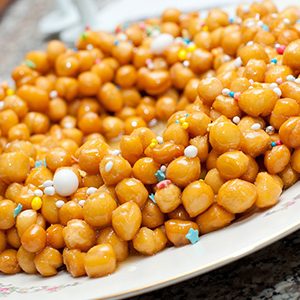

Search for:
- Sicilian Appetizers
- Sicilian Delicacies
- Baked Delicacies
- Pasta (Main Menu)
- Traditional Sicilian Pasta
- Meatless Pasta Recipes
- Legumes and Vegetables Pastas
- Rice Recipes
- Sauces and Condiments
- Meat Recipes
- Seafood Recipes
- Egg Recipes
- Salad Recipes
- Vegetable Recipes
- Sicilian Desserts
- Wines and Rosolio
- Festino – St. Rosalie's Feast
- Christmas – Natale
- Easter – Pasqua
- Saint Joseph Table
- The Regions of Italy
- The Northern Regions
- Etruscans & Central Regions
- The Samnites Regions
- The Greeks and The South
